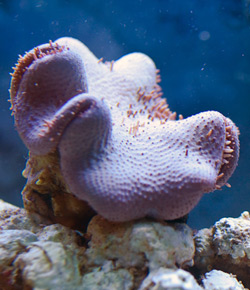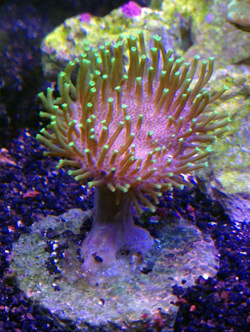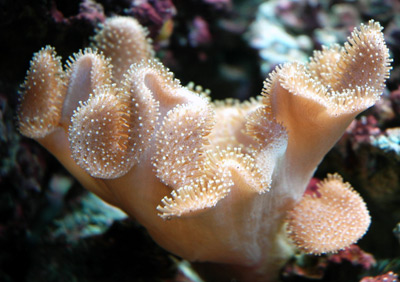When it comes to hardiness, ease of care, and general adaptability, few corals can compare to those of the genus Sarcophyton—the so-called toadstool, or mushroom, leather corals. Despite their lack of chromatic brilliance, they’re also pretty neat looking to boot.
Physical traits
As their common name implies, Sarcophyton spp. are typically mushroom- or toadstool-shaped—a solitary stalk topped with a broad capitulum (the “cap” of the mushroom), from which the polyps emerge. As the coral matures, the capitulum tends to become more wavy and convoluted, somewhat diminishing the mushroom-like appearance. The polyp size varies from species to species and in some cases can be quite long. These corals are leathery to the touch, hence the “leather coral” designation (a term applied to similarly textured soft coral species from several different genera).
Color-wise, sarcs tend to be muted, most sporting some shade of brown or cream, although yellow, green, or pinkish specimens are also available.
Keep in mind that some Sarcophyton spp. can reach massive sizes, with certain species ultimately exceeding three feet in diameter. It’s important to factor this in when considering tank size and placement for these corals.
Now you see ‘em, now you don’t

Don’t be alarmed when (not if) your Sarcophyton retracts its polyps and stays closed up for a few days. This is totally normal behavior that helps the coral rid its tissues of settled debris and algal growths. While the coral is in this state, you’ll notice a waxy mucus buildup developing on its surface, which it will soon shed. Once that occurs, the polyps will re-emerge and the coral will look as good as new. Note that the shed mucus can be irritating to other corals, so it should be siphoned/netted out of the tank if possible.
If your sarc seems to be going through this phase with excessive frequency or seems to have difficulty shedding the waxy coating, check all your water parameters and make sure the water flow around the specimen is sufficient.
A toxic lot
Another important consideration when keeping Sarcophyton corals is that they’re among the more noxious “chemical warriors” that we keep in reef tanks. Releasing chemicals into the water is a way for these corals to fend off neighboring corals so they don’t encroach on their real estate. In the closed system of an aquarium, these chemicals can cause problems with coral tankmates. So, if you notice “unexplainable” issues with other coral livestock—such as refusing to open or outright dying despite seemingly good water conditions, current, lighting, etc.—the Sarcophyton may very well be the culprit.
Lighting and current

As I alluded in my opening, Sarcophyton spp. are very hardy and can adapt to a wide range of lighting and current levels, provided the latter isn’t blasting the specimen. With respect to lighting, keep in mind that, despite their being adaptable, it’s still important to acclimate specimens slowly if they’ll be subjected to a significant change in intensity.
Easy propagation
Another selling point for these corals is their ease of propagation. Cuttings taken from any part of the coral will grow into new colonies. A common method is to trim around the margin of the capitulum and then cut the trimmed edge into smaller sections, which can be banded or tied to rocks or plugs, or placed atop rubble in a tray and allowed to attach naturally.



